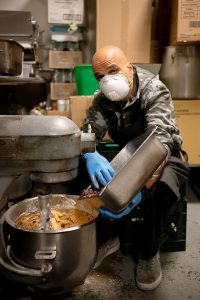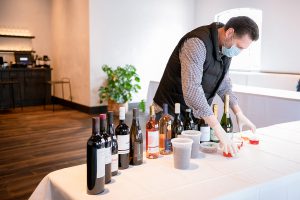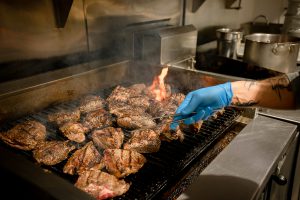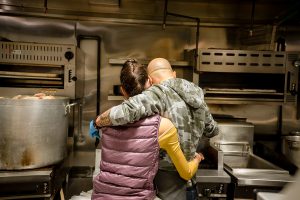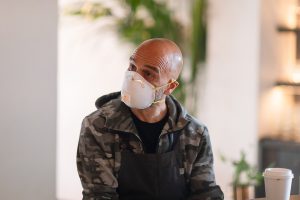Michelin-starred chef Mourad Lahlou on helping laid-off workers and the future of food service

Chefs Mourad Lahlou and Frank Hanes prepare meals at Aziza in San Francisco on April 11, 2020. Onome Uyovbievbo/STAFF.
Alongside arts and entertainment, perhaps no other industry has been more shattered by the nationwide coronavirus shelter-in-place orders than food service. Of the 16 million unemployment claims filed since the crisis began in March through April 4, food service employees were cited as notable by all than two states that provided context, according to the U.S. Department of Labor.
Many have closed up shop for the time being, boarding up their windows. No portion of the food services sector has been spared—from fine dining to fast food. Even McDonald’s has taken a hit. That’s reflected in the Bay Area, where restaurants are only allowed to operate as delivery or take-out operations.
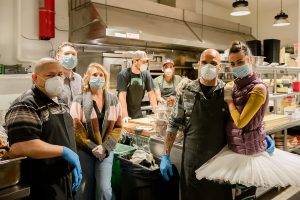
Aziza skeleton crew on April 11, 2020. Left to right: Cook Gaspar Poot-Che, Director of Operations Scott Chilcutt, General Manager Jessica Eisenberg, Chef de Cuisine Frank Hanes, cook Victor Perez, owner-chef Mourad Lahlou and his wife, SF Ballet dancer Mathilde Froustey.
“It’s been devastating, obviously, for everybody,” said Michelin-starred chef Mourad Lahlou, who owns Mourad and Aziza in San Francisco, and is a member of the Bay Area Hospitality Coalition (BAHC), which was quickly formed in the wake of California’s isolation orders as a response to the battle against Covid-19.
After the shutdown was ordered in mid-March, Lahlou had to suddenly furlough his entire staff—167 employees in San Francisco, as well as a crew in Hawaii, where he was days away from opening Miro Kaimuki, another restaurant. Plans to open additional eateries in Washington, D.C., and Los Angeles were halted. Mourad, his signature restaurant in SOMA, was shuttered. He’s kept a skeleton crew to run a takeout service at Aziza in the Richmond District.
“It’s something that you can never be prepared for,” he said. “I had to tell them overnight that they have to figure out a way to pay rent, figure out a way to feed themselves, figure out a way to commute. And because of the economics of the restaurant business, most people who are involved in it are basically paycheck to paycheck. Sometimes even week to week, sometimes even day to day, to be honest with you.
“These are people who make most of their money through tips,” he said.
Lahlou has already committed to covering the healthcare for his furloughed workers through the end of April and is trying to extend it through May by pulling from savings and contingency funds. He’s also started a GoFundMe account to help further. He couldn’t bear to tell them that they were completely on their own. The takeout service at Aziza, which he said pulls in just a fraction of what the restaurant made nightly before the pandemic, is meant to help the handful of employees still working, to help tax-paying undocumented workers—who won’t receive unemployment benefits or economic stimulus payments—and to provide meals to the community.
“We’re feeding the neighbors. … They can come, and we can be very meticulous and vigorous about the safety standards,” Lahlou said. “This keeps them from going to the supermarkets [where] they are likely to come into contact with more people.”
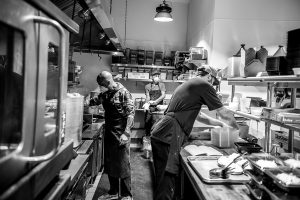
Chefs Mourad Lahlou (L) and Frank Hanes (R), and cook Victor Perez (center) prepare meals at Aziza in San Francisco on April 11, 2020.
Lahlou and his wife, San Francisco Ballet dancer Mathilde Froustey, have plans to start making breakfast and brunch boxes sourced from local bakeries and farmers markets to allow patrons to buy a full meal in one stop instead of having to visit multiple businesses. It’s one of the ways in which Lahlou is trying to pivot not only for the present situation but the post-coronavirus future.
At Aziza, he and his small remaining staff have also started making hundreds of meals for first responders and for the occupants of the city’s homeless shelters.
“Because of this pandemic, the shelters can’t produce food for them anymore because the cafeterias are shot, their kitchens are shot,” he said. “So they are going back onto the street. So all that work that’s been done to get them to get back on their feet is basically being flushed down the toilet. We’re making hundreds of meals a day and dropping them off in the shelters so [people] can stay in the shelters, and they don’t go back on the streets, which will make the pandemic even worse.”
Lahlou and Froustey (who’s volunteering) have been doing all this with a staff of four others, including Culinary Operations Director Mike Daley and Chef de Cuisine Frank Hanes. Before, Lahlou let his staff run the restaurants day-to-day, Froustey said. Now, he’s back to doing everything himself, from the cooking to the cleaning. He’s been mopping floors, washing dishes and cooking.
“It’s three to four people in the kitchen. And I haven’t seen him spending so much time in the kitchen before,” Froustey said.
Lahlou is a perfectionist in his craft, which has created additional obstacles for Aziza, a fine dining establishment that had never previously offered a takeout menu.
“We went from doing pretty food on pretty plates with elegant service … to basically a takeout joint,” he said.
This meant changing the way the food is prepared and presented. His describes his dishes as having a one-to-two-minute lifespan before it starts to die on the plate—basically, it needs to be eaten right away. What he’s had to do is extend that lifespan to survive the trip home and still be enjoyable.
Froustey said that on the first day of takeout service, the restaurant was still trying to provide white tablecloth service in a box, and her heart broke when one customer took a meal, which had been carefully prepared with tweezers, and slid it sideways into a backpack so it could survive a bike ride. She could picture everything sliding to one end of the box; the meticulous presentation ruined.
Now they’re being less careful about placing the floral garnish “between the pea and the carrot,” he said.
“It’s still beautiful food,” Froustey said. “They’re still doing Michelin star food—in a box, which is insane.”
For their part, existing Aziza customers have not complained at all. In the beginning, it was more about them supporting the restaurant while giving Lahlou time to get the recipes and presentation figured out. The chef felt somewhat embarrassed about the way the food was going out. But after a couple of weeks, he began to be proud of what the restaurant was making and serving once again.
The quality of the food alone won’t save Aziza and Mourad and thousands of other restaurants nationwide, however. It will come down to help from the government. The $2-trillion CARES act for coronavirus aid included the $349-billion Paycheck Protection Program for small businesses.
This plan gives restauranteurs 2.5 times their monthly salary budget, but 75 percent of that has to be spent to bring back employees at their preexisting employment levels.
But Lahlou and many other restaurant owners say it’s inadequate to take care of the food service industry. As long as the shutdown continues, there’s not enough work for those employees, he said.
Additionally, the PPP doesn’t account for the tips on which many restaurant workers depend. The idea was that workers would be paid to not come in to work so they don’t file for unemployment, he said.
Even when restaurants do get the go-ahead to reopen, it won’t be at full-strength, he said. They will likely have to operate at about 50-percent capacity at first. For most restaurants, operating at even 85 percent is a losing battle.
“Because of the margins of the restaurant business, I’m not sure that even some of the most successful restaurants can operate at half occupancy and still make it,” he said.
“So even if we have this money, and we want to get people to come back and work, they will say, ‘Well, there’s no tips. I’m better off on unemployment,” he said. “But if you don’t spend that money on hiring people back, what ends up happening is, it’s not a forgivable [loan] anymore. You have to pay it back to the government, and you have two years to do it, at 1 percent interest. What restaurant can be in this deep of a hole to start with? And then when we open, we have to pay back loans within two years, and pay back deferred rent, then pay back deferred insurance premiums. It’s almost easier to just file for bankruptcy and start again if you can.
“I doubt if any of [the legislators who wrote the PPP] has ever owned a restaurant or a bar or hotel,” he said.
That’s why Lahlou and several other chefs and restaurant owners, who ended up creating the Bay Area Hospitality Coalition, an advocacy group lobbying the government for amendments to the aid packages being offered to the industry, as well as providing an up-to-the-minute informational resource for industry workers and managers.
“Nobody knows what to do, and nobody knows what to apply for,” he said, adding that some of the grant and loan offers are exclusive; those who apply for one aren’t eligible for another.
“We’re trying to look beyond opening the doors again. We’re trying to look at what would it take for us to be successful again. We need a lot of help from the federal government, from the local government, from the state government. There’s a lot of things that need to happen for us, and even then, what we think is probably half of us would not to be able to reopen.”
Lahlou said the BAHC has lobbied California Governor Gavin Newsom that if the state mandates that establishments reopen at 50-percent capacity, that the state subsidizes the other 50 percent.
“That’s how we can stay in business without having to … be on life support every night,” he said.
The future of dining out, according to Mourad Lahlou
Aziza and Mourad Owner-chef Mourad Lahlou predicts the future of the restaurant industry and how our dining experience will change.
May will remain a month of takeout. “Possibly at the end of June restaurants may begin to reopen. But it will be a very different experience. I don’t think people will be quick to go back to bars where they can be elbow to elbow with people sitting next to them that they don’t know. I don’t think communal tables are going to work anymore … where you’re sharing space and glasses and pitchers of water.”
People will value space. “I don’t know whether people for the near future would want to eat any kind of food that they feel like it’s been handled too much. I think the definition of fine dining is going to have to be looked at. Too many hands were touching the plate, or too many people placing every single ingredient or component of the dish.”
Service will change. “There’s going to be a change with the mechanics of service. Are servers and bussers and food runners going to be obligated to wear gloves and change them with every single table that they touch? We need to figure that out.”
Takeout is here to stay. “Any restaurant that will try to reopen with the same concept and business model as they had before the Covid-19, most of them would fail. The ones that are going to survive are the ones who are trying to figure out right now what they need to change in their business model to be able to weather the storm, get back open again and then prosper after that.”
Summer will be quiet and fall will be precarious. “During the summer, a lot of restaurants that reopen are probably not even going to make it. In the fall, people are going to be very cautious because that’s when the flu season starts again, and that’s when [scientists are] predicting that there might be a second wave of Covid-19 cases. If you’re sitting in a restaurant and somebody sneezes … everybody’s going to get up and leave. I don’t want to be sitting next to somebody who might potentially be sick. … It’s just not pleasant anymore.”
Neighborhood restaurants will recover faster than downtown locations. “There are people living here [near Aziza] and they will always live here. But even when the shutdown is over, people are going to still be working from home because they have the capability of working from home. Conventions are not going to just come back overnight. Hotels are not going to be filled overnight. Downtown [San Francisco] is going to be a ghost town for a lot longer than the neighborhoods. … Everything downtown that is related to high tech and financial district is going to take a lot longer. There are companies that are canceling [conventions in] September and October, which is a good indication that these conventions are not going to come back.”
Relief will hopefully arrive in 2021. “By [next] summer, they might be able to find the vaccine. Once the vaccine is out, and it’s been deployed to everybody who needs it, then I think people will feel a little bit more comfortable.”
Follow editor Roman Gokhman at Twitter.com/RomiTheWriter. Follow photographer Onome Uyovbievbo at Twitter.com/noitsonome and Instagram.com/ono.photography.

